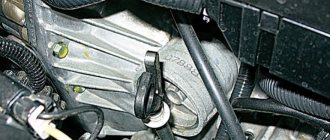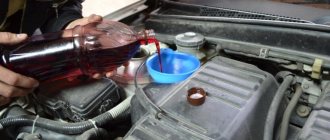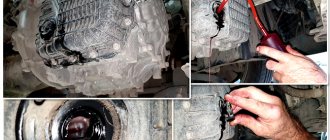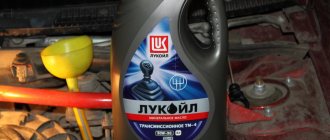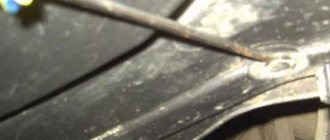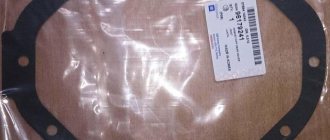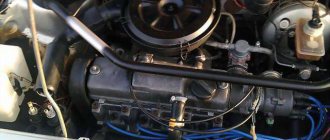One of the common mistakes made by car owners is filling the engine oil above the Max or Full level on the dipstick. The result can have serious consequences for both gasoline and diesel engines of such cars as Lada Vesta, Priora, Niva, Ford Focus 2, VAZ 2112/2114 and others.
Below we will look at what can happen if the oil is overfilled above the permissible level, and how to proceed to fix the problem.
First, let's talk about gasoline engines, and then we will separately pay attention to diesel engines. At the end we will also talk about motorcycles.
Make sure the oil level is correct
Before taking drastic steps, make sure that the problem really exists. To do this, you need to check the accuracy of the measurements again.
To avoid errors, make sure the following conditions are met:
- The machine is installed on a horizontal plane.
- Tire pressure is the same for everyone.
- The car is empty.
Particular attention should be paid to the temperature of the lubricant, which must be relevant for the test. Most often, manufacturers recommend taking measurements after 5-10 minutes from the moment the heated engine stops.
Procedure:
- Start the car.
- Let the engine run for at least 10 minutes at idle (until it warms up).
- Turn off the engine.
- Wait 2 – 5 minutes.
- Take a level measurement.
Some manufacturers recommend taking measurements “cold”. In such machines there are special marks on the probes for such measurements.
To carry out measurements, a probe is used, which is highly accurate and allows you to see an error of even 200-300 ml. This is why there is no need to use other measuring devices.
Note that inside the engine there is no more than 50% of the total volume that fits in the lubrication system, but this does not mean that you can pour an unlimited amount into the system; there is a limit to everything.
Why does overflow happen?
There are several reasons that can lead to overflow.
Random
In automotive practice, there is such a thing as an indelible residue - oil that remains in the system even after draining. Its volume ranges from 200 to 500 ml, but can be larger if the power unit is not fully heated.
When filling systems, the car owner fills in as much oil as the manufacturer recommends, and does not take into account the indelible residue. As a result, the level rises above the maximum level.
Deliberate
Some car owners believe that a slight excess is even good for the engine. It is believed that the power unit will still partially “eat” the excess. This is a false assumption that can ultimately lead to negative consequences.
During malfunctions
A common situation is when at first the dipstick shows the optimal level, but after some time the situation changes and it increases.
The reason may be the ingress of other technical fluids, for example, antifreeze or gasoline.
Diagnosing such a problem is very simple - just smell the smell of the lubricant, and also pay attention to its color.
In addition, when coolant gets into the oil, white exhaust gases appear, and at the same time the antifreeze level drops.
In older engines the situation is as follows:
- First, fuel enters the combustion chamber through damaged injectors.
- The fluid then seeps through the piston rings and into the crankcase.
The cause may also be damaged spark plugs that do not fire. As a result, unburnt fuel remains in the combustion chamber, also due to a broken gasket on the fuel pump.
Consequences of fuel getting into the oil sump:
- Loss of engine oil performance.
- A decrease in pressure in the system leads to oil starvation.
- Reduced compression.
- Excessive wear of parts of the cylinder-piston group, as well as their breakage due to heavy loads.
If the power unit is not too old, this situation can occur in the cold season, when you drive short distances and the engine does not have time to warm up.
There will be no consequences of a small amount of gasoline getting into the oil due to the rapid evaporation of the fuel, but the problem still needs to be solved.
The situation is more complicated if there is antifreeze in the oil. Typically, the cause of this is a blown cylinder head gasket.
In this case, excess “garbage” forms in the crankcase, and the properties of the lubricant deteriorate significantly. The result is accelerated wear of engine elements.
In this case, it is better to immediately go to a service station and use the services of a tow truck to protect the engine.
If you drive under your own power with such a malfunction, the situation may end in a major overhaul.
Incorrect oil change or topping up
Another reason, which partially overlaps with the first, is incomplete drainage of the lubricant during the replacement process due to haste.
In this case, the old place remains inside in the channels, pump, old filter that needs to be changed, and other elements. Subsequent filling of the required volume inevitably leads to an increase in the permissible level.
Vacuum oil pumping
Is a slight overflow acceptable?
The category of minor overflow refers to the situation when the oil level is higher than Max or Full by up to 10 mm. In this case, you should not count on serious consequences. Some car owners complain about a decrease in dynamics, but this is a false sensation.
Speaking in numerical terms, an excess of 100-200 ml is not terrible, but an overflow of 0.5-1 liters, as a rule, becomes a serious problem for the engine.
It is worth considering that even with a slight excess, the “gluttony” of the motor increases, and the excess lubricant “burns out” very quickly. In this case, the residues settle on the rings, cylinder walls or in the form of soot in the catalyst.
What can an elevated level lead to?
Exceeding the oil level above the permissible norm can lead to the following consequences:
- Reduced power level.
- Increased fuel consumption as the load on the crankshaft and pistons increases.
- Bubbling of lubricant by the crankshaft, which leads to foaming and an increase in the level of gases in the oil above the permissible level of 7%. The result is the appearance of knocking noise from hydraulic elements: tensioners, supports, pushers.
- Increased oil consumption.
- Blue smoke may appear from the exhaust system.
- The crankshaft flywheels run out against the oil, the latter foams, and the life of the crankshaft decreases.
In addition to those discussed above, other problems are possible:
- starting difficulties;
- the appearance of carbon deposits on engine elements;
- reduction in oil pump life;
- deterioration of the power unit;
- ignition problems;
- contamination of the catalyst and muffler;
- failure of spark plugs;
- improper operation of the engine crankcase ventilation system (EGR);
- the appearance of toxicity in the exhaust and other defects.
Exceeding the volume of lubricant is especially dangerous on older cars due to wear of the CPG and an increased volume of crankcase gases. The latter capture excess lubricant and carry it to the engine intake. This, in turn, leads to increased consumption and excessive exhaust smoke.
A turbocharged engine is also afraid of excessive amounts of oil, which in some models can get onto the walls of the compressor scroll and harden there.
As a result, the compressor wheels will touch the hardened deposits, increasing the load on the shaft bearings. They will wear out quickly and the turbine will fail.
Video “Practical instructions for removing excess oil from the engine”
A practical guide to pumping out excess fluid from a car power unit is given below (video filmed and published by the Smart City channel).
Do you have any questions? Specialists and readers of the AUTODVIG website will help you ask a question
Was this article helpful?
Thank you for your opinion!
The article was useful. Please share the information with your friends.
Yes (100.00%)
No
X
Please write what is wrong and leave recommendations on the article
Cancel reply
Rate this article: ( 2 votes, average: 5.00 out of 5)
Discuss the article:
What to do if you overfilled the oil above the maximum
If the oil level exceeds the norm, study the appropriate operating section for your car. The easiest way is to go to a service center and pump out such a volume so that the level is between the Min and Max marks.
Many service stations offer an express replacement service, when lubricant is pumped out through the dipstick tube or filler neck using special devices.
You can do the work yourself and to do this, use one of the following ways:
- Open the drain plug and drain some oil. Be careful to pour off only the excess portion. After this, measure the level.
- Pump out the oil through the dipstick tube. To do this, use a special or medical syringe for 20 cc (the first is sold in car dealerships, the second in pharmacies), a rubber tube (dropper). When choosing this option, be careful not to allow foreign objects or debris to get inside. Otherwise, it may damage the motor.
- The same can be done through the filler neck, but the length of the tube must be longer and this cannot be done in all cars; you will need special equipment, which is available at every service station.
Also, to pump out oil, you can use special kits, which include an electric pump and tubes.
Below is a table with filling volumes for some brands of cars.
| car brand | Volume, l |
| Priora | 3,2-3,4 |
| VAZ 2114 | 3,5 |
| VAZ 2112 16 valves | 3.5+0.3v oil filter |
| Kalina | 3,5 |
| Lada Granta | 3.2 for cars with manual transmission and 4.4 for cars with automatic transmission |
| Lada Vesta | 4.4, and for AMT – 3.2 l |
| Niva | 3,75 |
| Ford Focus 2 | 3,5 |
How to remove excess oil through the drain hole
At its core, this method is a regular oil change. But with one difference: the oil that is drained is not used. That is, the principle is this: the oil material is completely drained into a certain container, and then it is poured back, only in the correct quantity.
This option for removing excess is best done in a hole or on an overpass. Be sure to give the car time to cool completely. Because the oil is very hot (working temperature 90°) and can cause severe burns. Before the procedure, stock up on a container where the transmission fluid will be drained and a spanner wrench to unscrew the plug.
- When the vehicle has cooled down, you can proceed directly to removing the oil. To do this you need:
- Open the hood of the car and unscrew the filler cap.
- On the bottom surface of the motor, find where the drain plug is located.
- Before unscrewing the drain plug, place a container for oil liquid.
- Using a spanner wrench (can be replaced with a wrench), slowly and little by little unscrew the plug. In the end, you can usually tighten it with your hands, but be careful not to get yourself covered in oil.
Now you need to leave the car for about 30 minutes so that the transmission fluid drains out.
When the engine oil is full, the drain plug needs to be tightened. This must be done quite tightly, but without unnecessary zeal. If possible, it is better to use a torque wrench. In this case, the maximum tightening force should be no more than 25nm.
Now all that remains is to pour the lubricant back in. But carefully monitor the level so that there is no overflow again.
Motorcycles
The problem of exceeding the oil level is relevant not only for cars, but also for two-wheeled mechanized vehicles, as well as ATVs.
This applies to the vehicles listed above, both four-stroke wet-sump power units and two-stroke ones (in which oil is added to gasoline).
For 4-stroke engines
Each engine has a special breather installed to remove crankcase gases. While driving, excess oil (especially on a bad road) will come out through it. As a result, normal loss of lubrication occurs.
The remaining problems are similar to those listed above.
For 2-stroke engines
The same consequences as discussed above are relevant here, but we are no longer talking about exceeding the level.
For such engines, it is important to maintain the correct proportion of 1 to 50. This means that for 5 liters of gasoline you need to add about 100 million of engine lubricant.
Compliance with this rule is very important, because the appearance of excess oil leads to the following problems:
- The appearance of soot.
- Throwing candles.
- Difficulty starting the motorcycle engine.
- Malfunctions on the road (the engine periodically stalls).
- The appearance of bluish smoke from the exhaust system.
Methods for solving the problem
Problems with reducing oil volume in an automatic transmission are solved in the same way as those described above for a car engine. A medical syringe and an IV tube are also used. One end of it is put on the syringe, the other is lowered into the hole for the probe. Next, excess oil is removed.
To avoid troubles and breakdowns of the car transmission, it is useful to have the habit of checking the oil level in the automatic transmission about once a month (or about 1000 km).
You don’t have to worry too much about what will happen if you pour oil into a manual transmission - in this case everything is much simpler. Most likely, excess oil will squeeze out the breather or go through the drive shaft seals.

